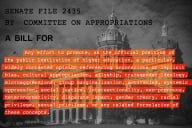You have /5 articles left.
Sign up for a free account or log in.

Although a wide body of research shows patients have better health outcomes when treated by a doctor of the same race or ethnicity, just 5.7 percent of active physicians are Black.
Getty Images
When the Einstein College of Medicine announced in February that a former faculty member donated a historic $1 billion to the institution to eliminate tuition for every student, leaders at the New York medical school lauded the gift’s potential to help diversify the physician workforce.
Removing Einstein’s nearly $60,000 per-year price tag “radically revolutionizes our ability to continue attracting students who are committed to our mission, not just those who can afford it,” Dr. Yaron Tomer, dean of the medical school, said in a press release. “We will be reminded of the legacy this historic gift represents each spring as we send another diverse class of physicians out across the Bronx and around the world to provide compassionate care and transform their communities.”
When Einstein becomes tuition-free next academic year, it will join a small but growing list of other medical schools that already have tuition-free programs, including the Cleveland Clinic Lerner College of Medicine at Case Western Reserve University, New York University Grossman College of Medicine and the Kaiser Permanente School of Medicine.
Other medical schools, including those at Columbia, Emory and Harvard Universities, have begun waiving tuition for some students based on financial need and merit in recent years.
While some experts in the medical field have applauded the financial relief these tuition-free medical schools provide, they’re skeptical that free tuition alone has the power to increase the racial diversity of medical school student populations or the overall number of doctors of color.
Although a wide body of research shows patients have better health outcomes when treated by a doctor of the same race or ethnicity, the racial diversity of the physician workforce doesn’t reflect the diversity of patients.
While white and Asian doctors are overrepresented in the field, Black and Hispanic doctors are underrepresented: About 14 percent of the total U.S. population is Black, but just 5.7 percent of active physicians are Black; 19 percent of the U.S. population is Hispanic, but just 6.9 percent of doctors are Hispanic, according to 2021 data from the American Association of Medical Colleges (AAMC). And despite Native Americans composing around 3 percent of the population, Native doctors make up about 0.4 percent of the physician workforce.
Financial barriers are certainly one piece of the picture.
It is well documented that Black, Hispanic and Native students are more likely than white students to come from low-income families. And that can make some students of color hesitant to take on more than $200,000 in debt, which is the norm for the average medical student, and commit to years of additional schooling before earning an attending physician’s healthy salary.
However, experts say it will take more than the largesse of a few deep-pocketed philanthropists to diversify the pipeline of aspiring doctors, especially as some state and federal lawmakers are adopting legislation banning diversity, equity and inclusion programs.
“Unless there’s other programmatic changes that would increase the total pool of students, the numbers won’t change,” said Dr. Billy Thomas, a neonatologist who served as the first vice-chancellor for diversity and inclusion at the University of Arkansas for Medical Sciences. “And if all of these DEI efforts are dissolved, then the number of minority students who can even apply to medical school is going to go down.”
That’s what happened after California voted to ban affirmative action in 1996, 27 years before the U.S. Supreme Court struck down race-conscious admissions nationally. By the late 1990s, the number of Black and Latinx students matriculating into California medical schools fell to historic lows (5 and 10 percent, respectively), according to a report from the Latinx Center for Excellence at the University of California at San Francisco.
But despite the ban on race-conscious admissions, things didn’t stay that way.
California medical schools have since launched numerous programs designed to attract students from underrepresented communities using strategies such as targeted recruitment, mentoring and advising. By 2019, 17 percent of students enrolled in a public medical school in California were Latinx and 11 percent were Black.
And all of that happened without the schools becoming blanketly tuition-free.
“There’s no singular solution to getting more qualified applicants in medical school,” said Julie Fresne, senior director of student financial and career advising services at the AAMC. “We need to start a lot earlier in helping students get to where they need to be and understand they can have a career in medicine and afford to go to medical school.”
Fresne said it’s too soon to tell if the roughly 10 medical schools with free tuition programs, several of which are housed at well-endowed private universities, are moving the needle on diversity. But the reality is that the majority of the 150-plus medical schools in the U.S. are reliant on tuition to run their programs and “it would be difficult for most medical schools to go tuition-free without a big gift,” she said.
Although applications to NYU’s medical school jumped nearly 50 percent—and more than 100 percent for underrepresented minorities, including Black, Latino and Native students—after it went tuition-free in 2018, it still only accepts around 2.7 percent of applicants.
The average student admitted to NYU’s medical school in 2023 had a near-perfect undergraduate GPA and high MCAT scores, while only 7 percent of them were the first in their families to attend college, according to the medical school’s website. While its website also says 24 percent of those student were from “groups underrepresented in medicine,” Black enrollment has been on the decline since the medical school went tuition-free, STAT News reported earlier this month.
Between 2019 and 2022, Black medical students at NYU averaged just under 11 percent, down from 14 percent in 2017. The number of medical school applications from Black, Hispanic and other underrepresented groups has fallen nationally partly because of the high cost of tuition, but also because these applicants are less likely to be admitted due to “entrenched issues of racial and socioeconomic disparities in medical school admissions” according to STAT.
But because so few medical schools offer free tuition—and so many students want to become doctors without taking on substantial debt—the applicant pool to those select few programs expands, and in turn becomes even more competitive.
“Those who have the highest grades may be more likely to get in,” said Norma Poll-Hunter, senior director of workforce diversity for the AAMC. “This is where holistic review is very helpful because it helps institutions focus on their mission.”
Holistic Review
Holistic review—or de-emphasizing standard assessments such as test scores and giving more weight to an applicant’s life experiences and attributes—is one of the approaches the Geisinger Commonwealth School of Medicine in northeastern Pennsylvania takes in reviewing applications for its tuition-free programs.
“We prioritize the admission of students who have grown up in rural communities because that’s our intention of service,” said Dr. Julie Byerley, dean of the medical college. “It’s common for applicants to say the right things. But we look for the applicant who really lives the right thing and is genuine in their desire to fulfill the mission and dreams we have for our program.”
Of the 118 students who started medical school at Geisinger this school year, 38 were socioeconomically disadvantaged, 16 were from groups underrepresented in medicine and 17 were first-generation college students.
According to data from the AAMC, white and Asian students still dominate the student body; of the 472 students enrolled at the medical school during the 2023–24 academic year, 18 were Black, 25 were Hispanic and none were Native.
Geisinger, which graduated its first class of 57 students in 2013, used to clear the debt of all admitted students as long as they returned to work in the Geisinger Health System for four years after completing a residency. The school has since narrowed its loan forgiveness program, which is now only available to students pursuing psychiatry and adult primary care, two of the most in-demand specialties.
Getting into medical school is just one of the first steps toward becoming a doctor. And Black, Hispanic and Native students are more likely to stop out of their programs than their white peers, according to a 2022 study published in the Journal of the American Medical Association (JAMA).
In an effort to help students make it through the rigors of medical education, Geisinger offers additional supports such as multiple advisors for each student and community-based education and programming through the Office of Health Equity and Inclusion.
The college also has a pathway program aimed at preparing K-12 students for future success in the health professions. Advisers from the medical school stay in touch with students in the program throughout their undergraduate years and help them apply to medical school. Of the 115 students graduating from Geisinger this year, 27 participated in the pathway program.
“The personal relationships and being known help students the most to get over those difficult feelings that come with being the first in their family to attend or being a distinct minority in the student population,” Byerley said.
While such efforts may help underrepresented students get through medical school, that hasn’t stopped some conservative lawmakers from trying to dismantle DEI initiatives at colleges and universities across the country.
North Carolina Congressman Greg Murphy, who is also a practicing urologist, proposed a bill last month prohibiting federal funding, including student loans, for medical schools with diversity, equity and inclusion-related policies and requirements.
Diversity and DEI Bans
In spite of these politicized efforts, Idia Binitie Thurston, associate director of the Institute for Health Equity and Social Justice Research at Northeastern University, said institutions should not abandon their diversity goals.
In a recent paper she co-authored for the JAMA Health Forum, Thurston outlined 13 strategies for increasing racial and ethnic diversity in the academic health sciences, which, in addition to financial support, includes pathway programs, holistic application review and mentoring programs.
While most medical schools don’t have donors who can write a $1 billion check and wipe away tuition, outside funding sources, such as grants, can still play a role in developing more targeted programs aimed at preparing underrepresented students for a medical career.
“The role of organizations funding this work is critical, especially because of the cancellation of DEI offices at institutions,” Thurston said. “If funders have grants they’re offering that can fund these pathway programs, that’s one of the most important things because funding helps to drive change.”
Thurston’s brother, Dr. Odion Binitie, an orthopedic surgeon at Moffitt Cancer Center in Tampa, is one of a small percentage of Black physicians in his field. On his path to becoming a surgeon, he became a mentee of the only Black professor at the University of South Florida’s medical school.
“Having his support was definitely beneficial. When I decided I wanted a career in surgery, I went to him and he directed me toward a surgeon who I eventually started working with,” said Binitie, who now serves as a mentor in a local pathway program designed to equip underrepresented and disadvantaged K-12 students for careers in medicine.
“It’s part of the reason I want to pay it forward,” he said.
There were no tuition-free options when Binite was applying to med school and he was prepared to take out loans.
Like most applicants, he applied to numerous medical schools to increase chances in a highly competitive process, including the Howard University College of Medicine, one of four medical schools at a historically black college.
Black medical students who attend HBCUs report higher degrees of confidence in their academic abilities and a greater sense of belonging than their peers who attend predominantly white medical schools, according to a 2022 study in the Journal of General Internal Medicine.
As of 2019, about 10 percent of Black doctors graduated from medical schools at HBCUs, according to the AAMC.
“If you’re one of a few Black or Brown students in your medical school and you’re not doing well, you may be less likely to go to an advisor because you don’t want to get singled out as the only Black person not doing well,” Binitie said. “At an HBCU, you don’t feel singled out as the only minority in the class, and you may be more willing to seek support.”
But Binitie didn’t get into Howard’s medical school; Only around 3.7 percent of applicants do. Instead he went to the University of South Florida’s medical college after he got a scholarship and connected with the Black professor who became his mentor during the interview process.
He is encouraged that tuition-free programs are helping some medical students graduate without substantial debt. But Binitie, who has experienced his share of racial microaggressions during his career, says it will take more than money to diversify the physician workforce.
“If it’s still the same group of students coming in, it may not increase the diversity of the students,” he said. “I’m not aware of money fixing anything when it comes to diversity.”







